NURS1002 Assessment Report: Screening Program for Obesity
VerifiedAdded on 2023/06/09
|7
|1898
|187
Report
AI Summary
This report assesses the effectiveness of obesity screening programs, highlighting their benefits in early risk identification and intervention. It explores appropriate health history questions to identify individual risk factors, emphasizing diet, lifestyle, and genetics. The report summarizes key health promotion messages, including regular exercise, healthy eating, and stress management. It also provides local and online resources for further information and support. The conclusion recommends the continuation and expansion of obesity screening programs to improve public health outcomes and quality of life. This NURS1002 assessment provides a rationale for the continuation of the screening program.
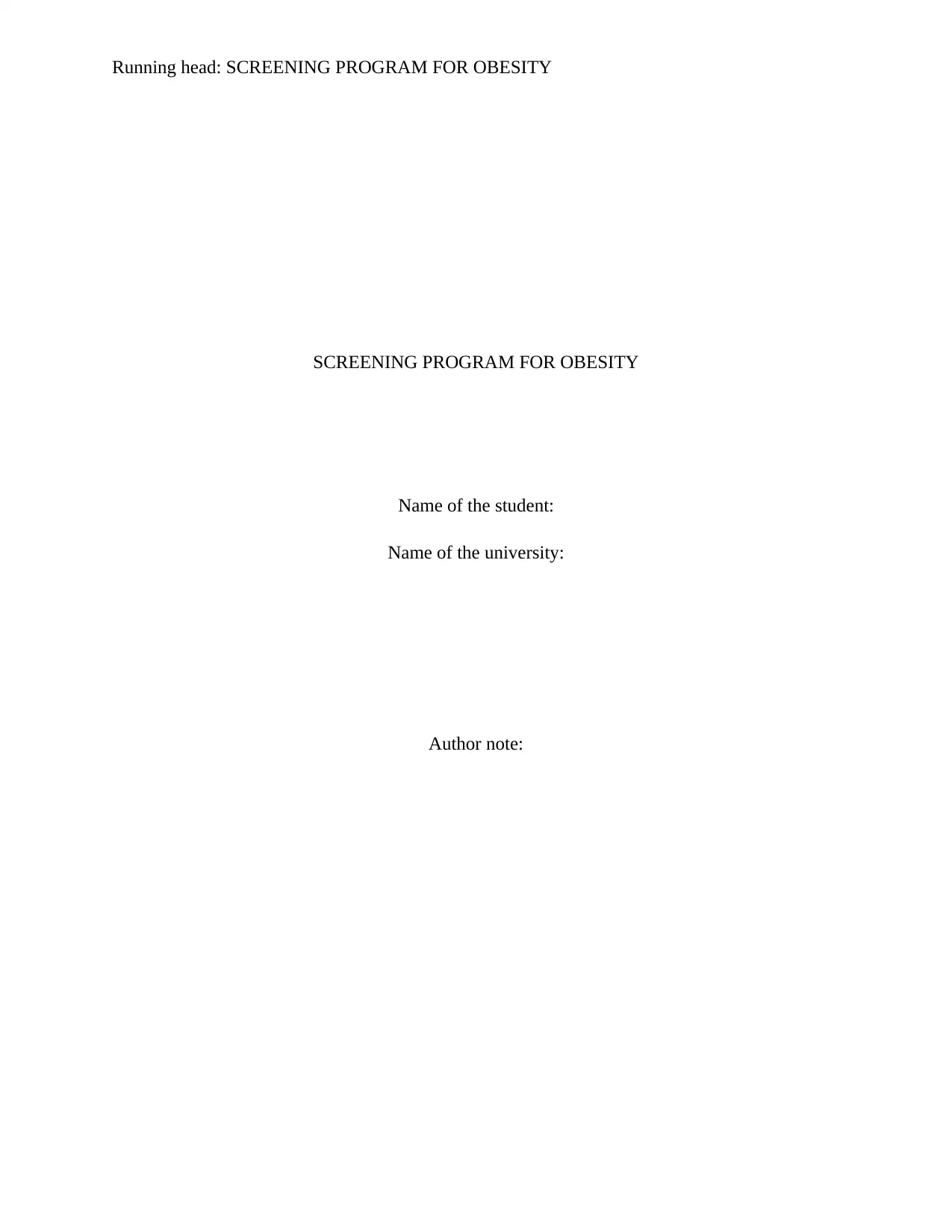
Running head: SCREENING PROGRAM FOR OBESITY
SCREENING PROGRAM FOR OBESITY
Name of the student:
Name of the university:
Author note:
SCREENING PROGRAM FOR OBESITY
Name of the student:
Name of the university:
Author note:
Paraphrase This Document
Need a fresh take? Get an instant paraphrase of this document with our AI Paraphraser
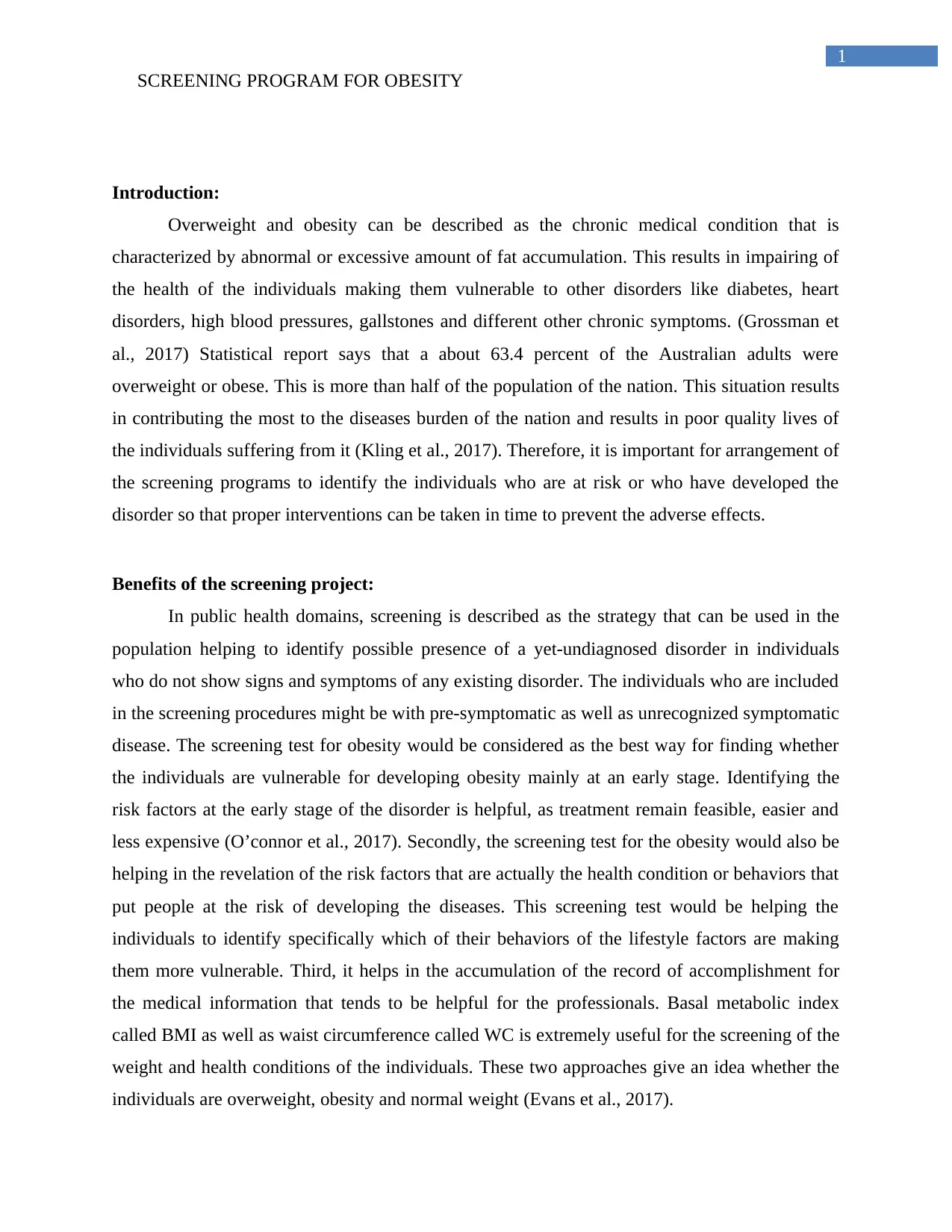
1
SCREENING PROGRAM FOR OBESITY
Introduction:
Overweight and obesity can be described as the chronic medical condition that is
characterized by abnormal or excessive amount of fat accumulation. This results in impairing of
the health of the individuals making them vulnerable to other disorders like diabetes, heart
disorders, high blood pressures, gallstones and different other chronic symptoms. (Grossman et
al., 2017) Statistical report says that a about 63.4 percent of the Australian adults were
overweight or obese. This is more than half of the population of the nation. This situation results
in contributing the most to the diseases burden of the nation and results in poor quality lives of
the individuals suffering from it (Kling et al., 2017). Therefore, it is important for arrangement of
the screening programs to identify the individuals who are at risk or who have developed the
disorder so that proper interventions can be taken in time to prevent the adverse effects.
Benefits of the screening project:
In public health domains, screening is described as the strategy that can be used in the
population helping to identify possible presence of a yet-undiagnosed disorder in individuals
who do not show signs and symptoms of any existing disorder. The individuals who are included
in the screening procedures might be with pre-symptomatic as well as unrecognized symptomatic
disease. The screening test for obesity would be considered as the best way for finding whether
the individuals are vulnerable for developing obesity mainly at an early stage. Identifying the
risk factors at the early stage of the disorder is helpful, as treatment remain feasible, easier and
less expensive (O’connor et al., 2017). Secondly, the screening test for the obesity would also be
helping in the revelation of the risk factors that are actually the health condition or behaviors that
put people at the risk of developing the diseases. This screening test would be helping the
individuals to identify specifically which of their behaviors of the lifestyle factors are making
them more vulnerable. Third, it helps in the accumulation of the record of accomplishment for
the medical information that tends to be helpful for the professionals. Basal metabolic index
called BMI as well as waist circumference called WC is extremely useful for the screening of the
weight and health conditions of the individuals. These two approaches give an idea whether the
individuals are overweight, obesity and normal weight (Evans et al., 2017).
SCREENING PROGRAM FOR OBESITY
Introduction:
Overweight and obesity can be described as the chronic medical condition that is
characterized by abnormal or excessive amount of fat accumulation. This results in impairing of
the health of the individuals making them vulnerable to other disorders like diabetes, heart
disorders, high blood pressures, gallstones and different other chronic symptoms. (Grossman et
al., 2017) Statistical report says that a about 63.4 percent of the Australian adults were
overweight or obese. This is more than half of the population of the nation. This situation results
in contributing the most to the diseases burden of the nation and results in poor quality lives of
the individuals suffering from it (Kling et al., 2017). Therefore, it is important for arrangement of
the screening programs to identify the individuals who are at risk or who have developed the
disorder so that proper interventions can be taken in time to prevent the adverse effects.
Benefits of the screening project:
In public health domains, screening is described as the strategy that can be used in the
population helping to identify possible presence of a yet-undiagnosed disorder in individuals
who do not show signs and symptoms of any existing disorder. The individuals who are included
in the screening procedures might be with pre-symptomatic as well as unrecognized symptomatic
disease. The screening test for obesity would be considered as the best way for finding whether
the individuals are vulnerable for developing obesity mainly at an early stage. Identifying the
risk factors at the early stage of the disorder is helpful, as treatment remain feasible, easier and
less expensive (O’connor et al., 2017). Secondly, the screening test for the obesity would also be
helping in the revelation of the risk factors that are actually the health condition or behaviors that
put people at the risk of developing the diseases. This screening test would be helping the
individuals to identify specifically which of their behaviors of the lifestyle factors are making
them more vulnerable. Third, it helps in the accumulation of the record of accomplishment for
the medical information that tends to be helpful for the professionals. Basal metabolic index
called BMI as well as waist circumference called WC is extremely useful for the screening of the
weight and health conditions of the individuals. These two approaches give an idea whether the
individuals are overweight, obesity and normal weight (Evans et al., 2017).
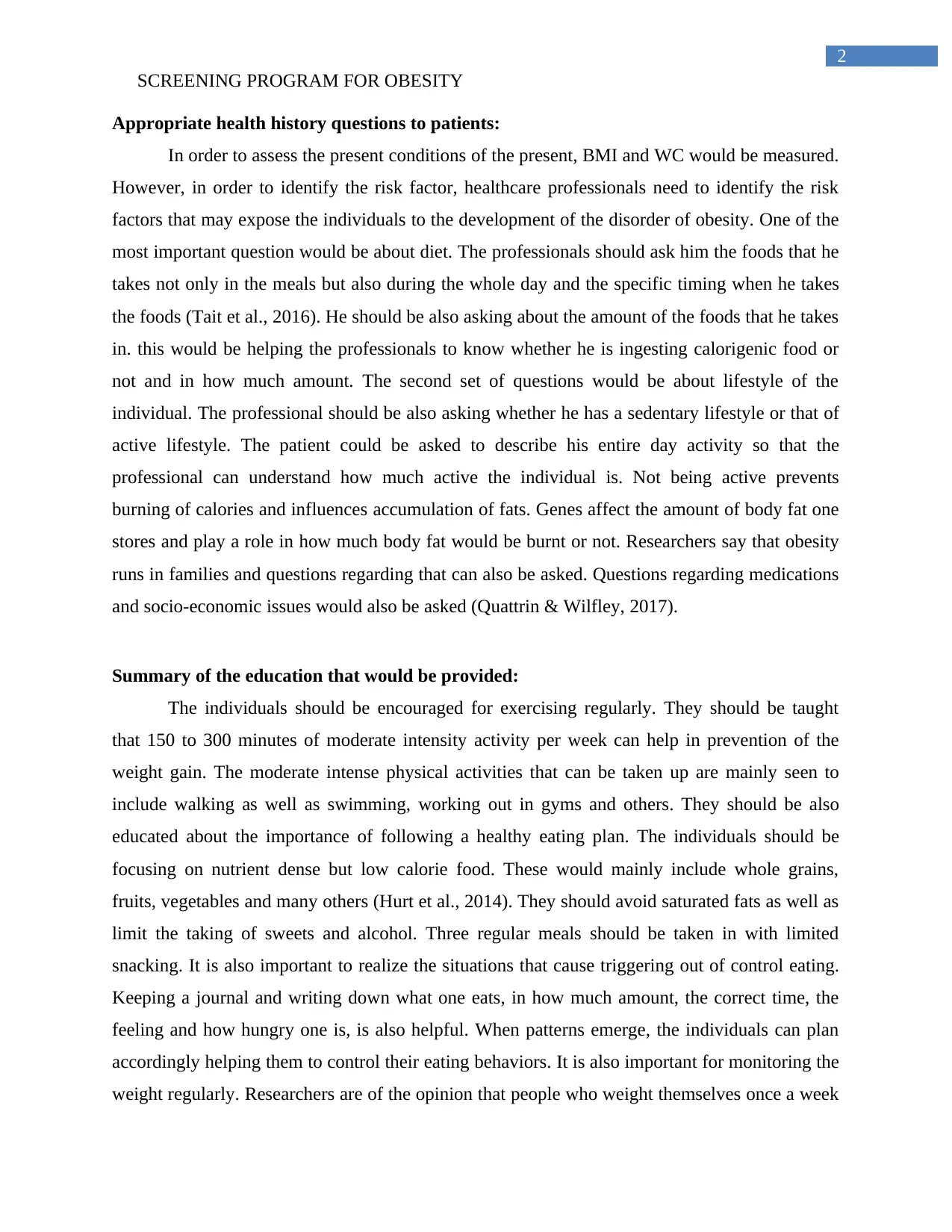
2
SCREENING PROGRAM FOR OBESITY
Appropriate health history questions to patients:
In order to assess the present conditions of the present, BMI and WC would be measured.
However, in order to identify the risk factor, healthcare professionals need to identify the risk
factors that may expose the individuals to the development of the disorder of obesity. One of the
most important question would be about diet. The professionals should ask him the foods that he
takes not only in the meals but also during the whole day and the specific timing when he takes
the foods (Tait et al., 2016). He should be also asking about the amount of the foods that he takes
in. this would be helping the professionals to know whether he is ingesting calorigenic food or
not and in how much amount. The second set of questions would be about lifestyle of the
individual. The professional should be also asking whether he has a sedentary lifestyle or that of
active lifestyle. The patient could be asked to describe his entire day activity so that the
professional can understand how much active the individual is. Not being active prevents
burning of calories and influences accumulation of fats. Genes affect the amount of body fat one
stores and play a role in how much body fat would be burnt or not. Researchers say that obesity
runs in families and questions regarding that can also be asked. Questions regarding medications
and socio-economic issues would also be asked (Quattrin & Wilfley, 2017).
Summary of the education that would be provided:
The individuals should be encouraged for exercising regularly. They should be taught
that 150 to 300 minutes of moderate intensity activity per week can help in prevention of the
weight gain. The moderate intense physical activities that can be taken up are mainly seen to
include walking as well as swimming, working out in gyms and others. They should be also
educated about the importance of following a healthy eating plan. The individuals should be
focusing on nutrient dense but low calorie food. These would mainly include whole grains,
fruits, vegetables and many others (Hurt et al., 2014). They should avoid saturated fats as well as
limit the taking of sweets and alcohol. Three regular meals should be taken in with limited
snacking. It is also important to realize the situations that cause triggering out of control eating.
Keeping a journal and writing down what one eats, in how much amount, the correct time, the
feeling and how hungry one is, is also helpful. When patterns emerge, the individuals can plan
accordingly helping them to control their eating behaviors. It is also important for monitoring the
weight regularly. Researchers are of the opinion that people who weight themselves once a week
SCREENING PROGRAM FOR OBESITY
Appropriate health history questions to patients:
In order to assess the present conditions of the present, BMI and WC would be measured.
However, in order to identify the risk factor, healthcare professionals need to identify the risk
factors that may expose the individuals to the development of the disorder of obesity. One of the
most important question would be about diet. The professionals should ask him the foods that he
takes not only in the meals but also during the whole day and the specific timing when he takes
the foods (Tait et al., 2016). He should be also asking about the amount of the foods that he takes
in. this would be helping the professionals to know whether he is ingesting calorigenic food or
not and in how much amount. The second set of questions would be about lifestyle of the
individual. The professional should be also asking whether he has a sedentary lifestyle or that of
active lifestyle. The patient could be asked to describe his entire day activity so that the
professional can understand how much active the individual is. Not being active prevents
burning of calories and influences accumulation of fats. Genes affect the amount of body fat one
stores and play a role in how much body fat would be burnt or not. Researchers say that obesity
runs in families and questions regarding that can also be asked. Questions regarding medications
and socio-economic issues would also be asked (Quattrin & Wilfley, 2017).
Summary of the education that would be provided:
The individuals should be encouraged for exercising regularly. They should be taught
that 150 to 300 minutes of moderate intensity activity per week can help in prevention of the
weight gain. The moderate intense physical activities that can be taken up are mainly seen to
include walking as well as swimming, working out in gyms and others. They should be also
educated about the importance of following a healthy eating plan. The individuals should be
focusing on nutrient dense but low calorie food. These would mainly include whole grains,
fruits, vegetables and many others (Hurt et al., 2014). They should avoid saturated fats as well as
limit the taking of sweets and alcohol. Three regular meals should be taken in with limited
snacking. It is also important to realize the situations that cause triggering out of control eating.
Keeping a journal and writing down what one eats, in how much amount, the correct time, the
feeling and how hungry one is, is also helpful. When patterns emerge, the individuals can plan
accordingly helping them to control their eating behaviors. It is also important for monitoring the
weight regularly. Researchers are of the opinion that people who weight themselves once a week
⊘ This is a preview!⊘
Do you want full access?
Subscribe today to unlock all pages.

Trusted by 1+ million students worldwide
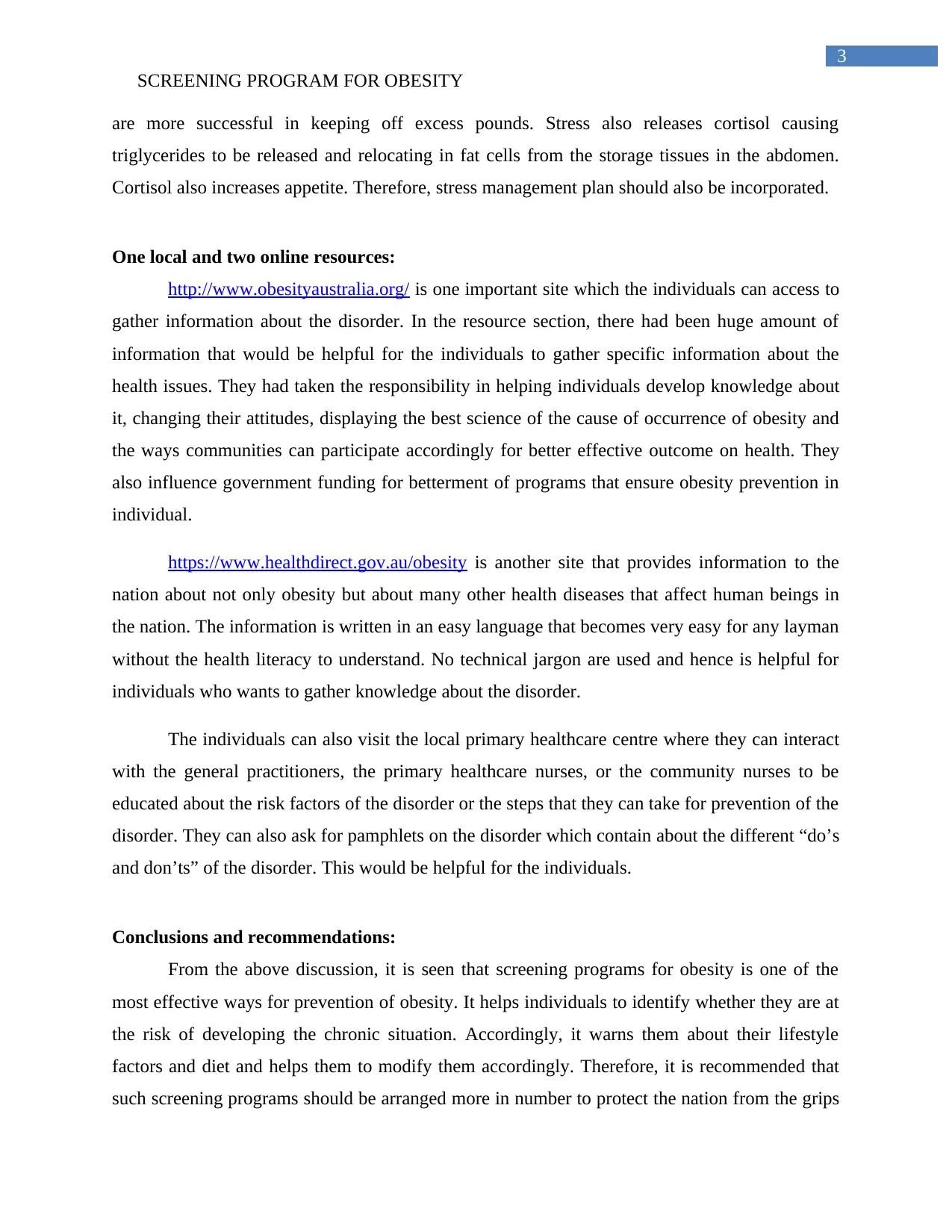
3
SCREENING PROGRAM FOR OBESITY
are more successful in keeping off excess pounds. Stress also releases cortisol causing
triglycerides to be released and relocating in fat cells from the storage tissues in the abdomen.
Cortisol also increases appetite. Therefore, stress management plan should also be incorporated.
One local and two online resources:
http://www.obesityaustralia.org/ is one important site which the individuals can access to
gather information about the disorder. In the resource section, there had been huge amount of
information that would be helpful for the individuals to gather specific information about the
health issues. They had taken the responsibility in helping individuals develop knowledge about
it, changing their attitudes, displaying the best science of the cause of occurrence of obesity and
the ways communities can participate accordingly for better effective outcome on health. They
also influence government funding for betterment of programs that ensure obesity prevention in
individual.
https://www.healthdirect.gov.au/obesity is another site that provides information to the
nation about not only obesity but about many other health diseases that affect human beings in
the nation. The information is written in an easy language that becomes very easy for any layman
without the health literacy to understand. No technical jargon are used and hence is helpful for
individuals who wants to gather knowledge about the disorder.
The individuals can also visit the local primary healthcare centre where they can interact
with the general practitioners, the primary healthcare nurses, or the community nurses to be
educated about the risk factors of the disorder or the steps that they can take for prevention of the
disorder. They can also ask for pamphlets on the disorder which contain about the different “do’s
and don’ts” of the disorder. This would be helpful for the individuals.
Conclusions and recommendations:
From the above discussion, it is seen that screening programs for obesity is one of the
most effective ways for prevention of obesity. It helps individuals to identify whether they are at
the risk of developing the chronic situation. Accordingly, it warns them about their lifestyle
factors and diet and helps them to modify them accordingly. Therefore, it is recommended that
such screening programs should be arranged more in number to protect the nation from the grips
SCREENING PROGRAM FOR OBESITY
are more successful in keeping off excess pounds. Stress also releases cortisol causing
triglycerides to be released and relocating in fat cells from the storage tissues in the abdomen.
Cortisol also increases appetite. Therefore, stress management plan should also be incorporated.
One local and two online resources:
http://www.obesityaustralia.org/ is one important site which the individuals can access to
gather information about the disorder. In the resource section, there had been huge amount of
information that would be helpful for the individuals to gather specific information about the
health issues. They had taken the responsibility in helping individuals develop knowledge about
it, changing their attitudes, displaying the best science of the cause of occurrence of obesity and
the ways communities can participate accordingly for better effective outcome on health. They
also influence government funding for betterment of programs that ensure obesity prevention in
individual.
https://www.healthdirect.gov.au/obesity is another site that provides information to the
nation about not only obesity but about many other health diseases that affect human beings in
the nation. The information is written in an easy language that becomes very easy for any layman
without the health literacy to understand. No technical jargon are used and hence is helpful for
individuals who wants to gather knowledge about the disorder.
The individuals can also visit the local primary healthcare centre where they can interact
with the general practitioners, the primary healthcare nurses, or the community nurses to be
educated about the risk factors of the disorder or the steps that they can take for prevention of the
disorder. They can also ask for pamphlets on the disorder which contain about the different “do’s
and don’ts” of the disorder. This would be helpful for the individuals.
Conclusions and recommendations:
From the above discussion, it is seen that screening programs for obesity is one of the
most effective ways for prevention of obesity. It helps individuals to identify whether they are at
the risk of developing the chronic situation. Accordingly, it warns them about their lifestyle
factors and diet and helps them to modify them accordingly. Therefore, it is recommended that
such screening programs should be arranged more in number to protect the nation from the grips
Paraphrase This Document
Need a fresh take? Get an instant paraphrase of this document with our AI Paraphraser
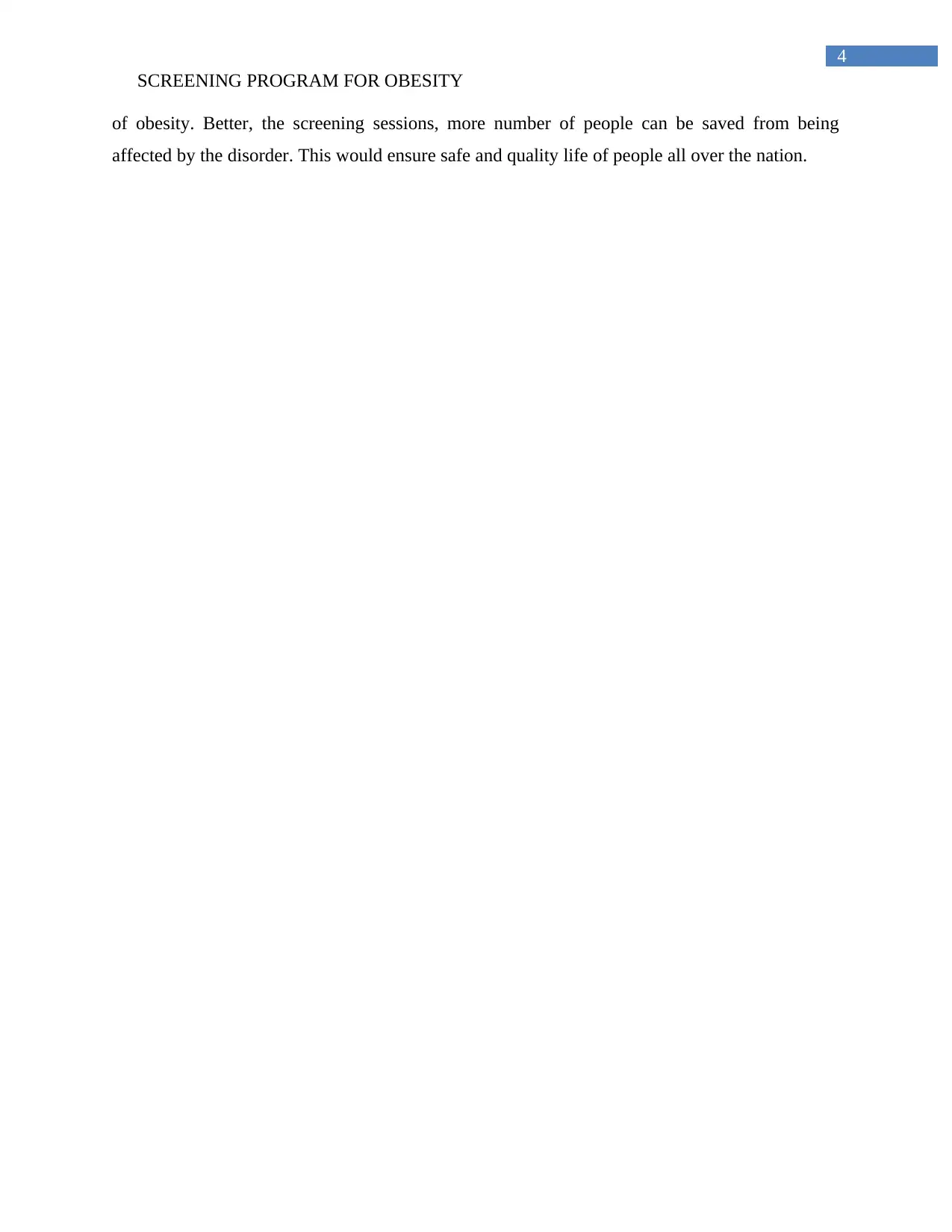
4
SCREENING PROGRAM FOR OBESITY
of obesity. Better, the screening sessions, more number of people can be saved from being
affected by the disorder. This would ensure safe and quality life of people all over the nation.
SCREENING PROGRAM FOR OBESITY
of obesity. Better, the screening sessions, more number of people can be saved from being
affected by the disorder. This would ensure safe and quality life of people all over the nation.
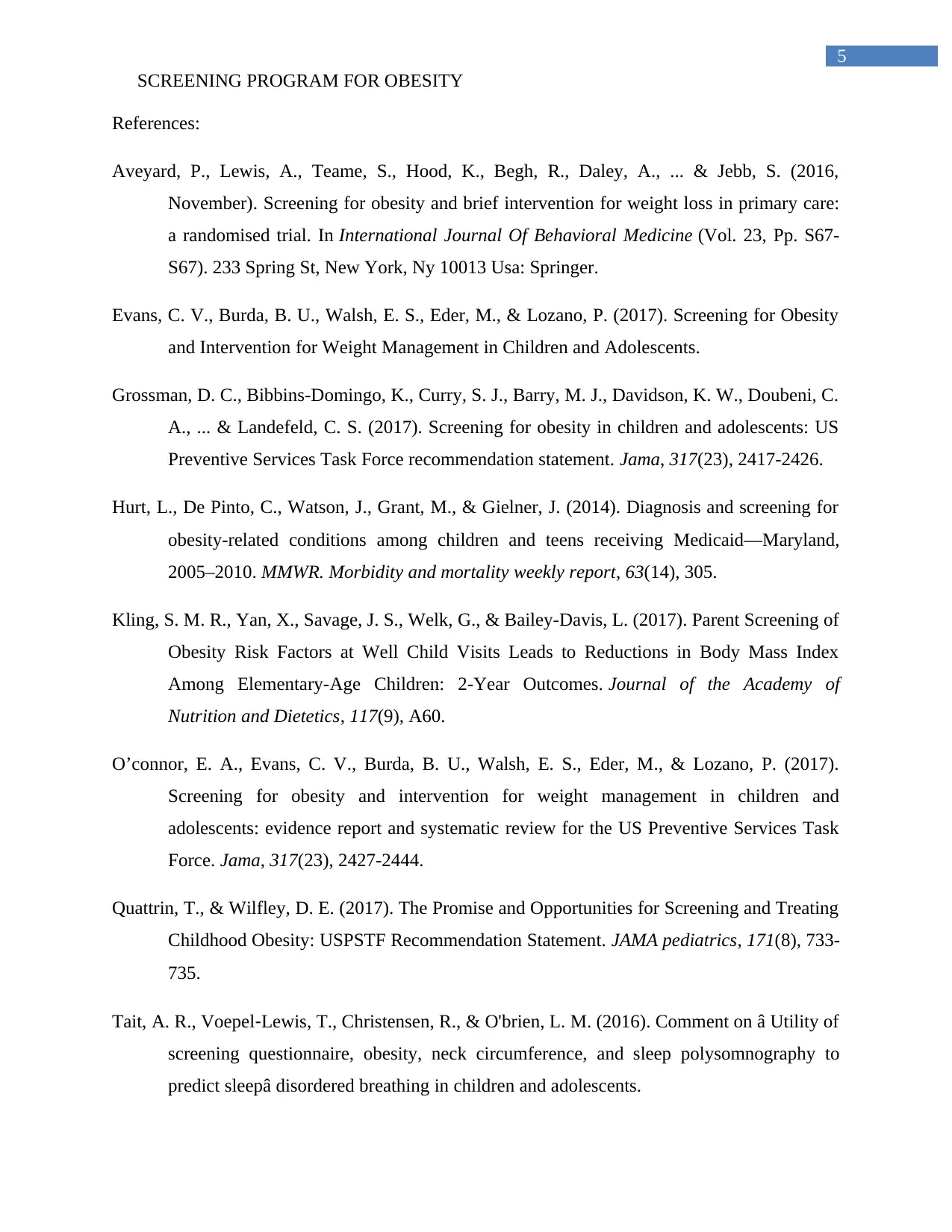
5
SCREENING PROGRAM FOR OBESITY
References:
Aveyard, P., Lewis, A., Teame, S., Hood, K., Begh, R., Daley, A., ... & Jebb, S. (2016,
November). Screening for obesity and brief intervention for weight loss in primary care:
a randomised trial. In International Journal Of Behavioral Medicine (Vol. 23, Pp. S67-
S67). 233 Spring St, New York, Ny 10013 Usa: Springer.
Evans, C. V., Burda, B. U., Walsh, E. S., Eder, M., & Lozano, P. (2017). Screening for Obesity
and Intervention for Weight Management in Children and Adolescents.
Grossman, D. C., Bibbins-Domingo, K., Curry, S. J., Barry, M. J., Davidson, K. W., Doubeni, C.
A., ... & Landefeld, C. S. (2017). Screening for obesity in children and adolescents: US
Preventive Services Task Force recommendation statement. Jama, 317(23), 2417-2426.
Hurt, L., De Pinto, C., Watson, J., Grant, M., & Gielner, J. (2014). Diagnosis and screening for
obesity-related conditions among children and teens receiving Medicaid—Maryland,
2005–2010. MMWR. Morbidity and mortality weekly report, 63(14), 305.
Kling, S. M. R., Yan, X., Savage, J. S., Welk, G., & Bailey-Davis, L. (2017). Parent Screening of
Obesity Risk Factors at Well Child Visits Leads to Reductions in Body Mass Index
Among Elementary-Age Children: 2-Year Outcomes. Journal of the Academy of
Nutrition and Dietetics, 117(9), A60.
O’connor, E. A., Evans, C. V., Burda, B. U., Walsh, E. S., Eder, M., & Lozano, P. (2017).
Screening for obesity and intervention for weight management in children and
adolescents: evidence report and systematic review for the US Preventive Services Task
Force. Jama, 317(23), 2427-2444.
Quattrin, T., & Wilfley, D. E. (2017). The Promise and Opportunities for Screening and Treating
Childhood Obesity: USPSTF Recommendation Statement. JAMA pediatrics, 171(8), 733-
735.
Tait, A. R., Voepel‐Lewis, T., Christensen, R., & O'brien, L. M. (2016). Comment on â Utility of
screening questionnaire, obesity, neck circumference, and sleep polysomnography to
predict sleepâ disordered breathing in children and adolescents.
SCREENING PROGRAM FOR OBESITY
References:
Aveyard, P., Lewis, A., Teame, S., Hood, K., Begh, R., Daley, A., ... & Jebb, S. (2016,
November). Screening for obesity and brief intervention for weight loss in primary care:
a randomised trial. In International Journal Of Behavioral Medicine (Vol. 23, Pp. S67-
S67). 233 Spring St, New York, Ny 10013 Usa: Springer.
Evans, C. V., Burda, B. U., Walsh, E. S., Eder, M., & Lozano, P. (2017). Screening for Obesity
and Intervention for Weight Management in Children and Adolescents.
Grossman, D. C., Bibbins-Domingo, K., Curry, S. J., Barry, M. J., Davidson, K. W., Doubeni, C.
A., ... & Landefeld, C. S. (2017). Screening for obesity in children and adolescents: US
Preventive Services Task Force recommendation statement. Jama, 317(23), 2417-2426.
Hurt, L., De Pinto, C., Watson, J., Grant, M., & Gielner, J. (2014). Diagnosis and screening for
obesity-related conditions among children and teens receiving Medicaid—Maryland,
2005–2010. MMWR. Morbidity and mortality weekly report, 63(14), 305.
Kling, S. M. R., Yan, X., Savage, J. S., Welk, G., & Bailey-Davis, L. (2017). Parent Screening of
Obesity Risk Factors at Well Child Visits Leads to Reductions in Body Mass Index
Among Elementary-Age Children: 2-Year Outcomes. Journal of the Academy of
Nutrition and Dietetics, 117(9), A60.
O’connor, E. A., Evans, C. V., Burda, B. U., Walsh, E. S., Eder, M., & Lozano, P. (2017).
Screening for obesity and intervention for weight management in children and
adolescents: evidence report and systematic review for the US Preventive Services Task
Force. Jama, 317(23), 2427-2444.
Quattrin, T., & Wilfley, D. E. (2017). The Promise and Opportunities for Screening and Treating
Childhood Obesity: USPSTF Recommendation Statement. JAMA pediatrics, 171(8), 733-
735.
Tait, A. R., Voepel‐Lewis, T., Christensen, R., & O'brien, L. M. (2016). Comment on â Utility of
screening questionnaire, obesity, neck circumference, and sleep polysomnography to
predict sleepâ disordered breathing in children and adolescents.
⊘ This is a preview!⊘
Do you want full access?
Subscribe today to unlock all pages.

Trusted by 1+ million students worldwide
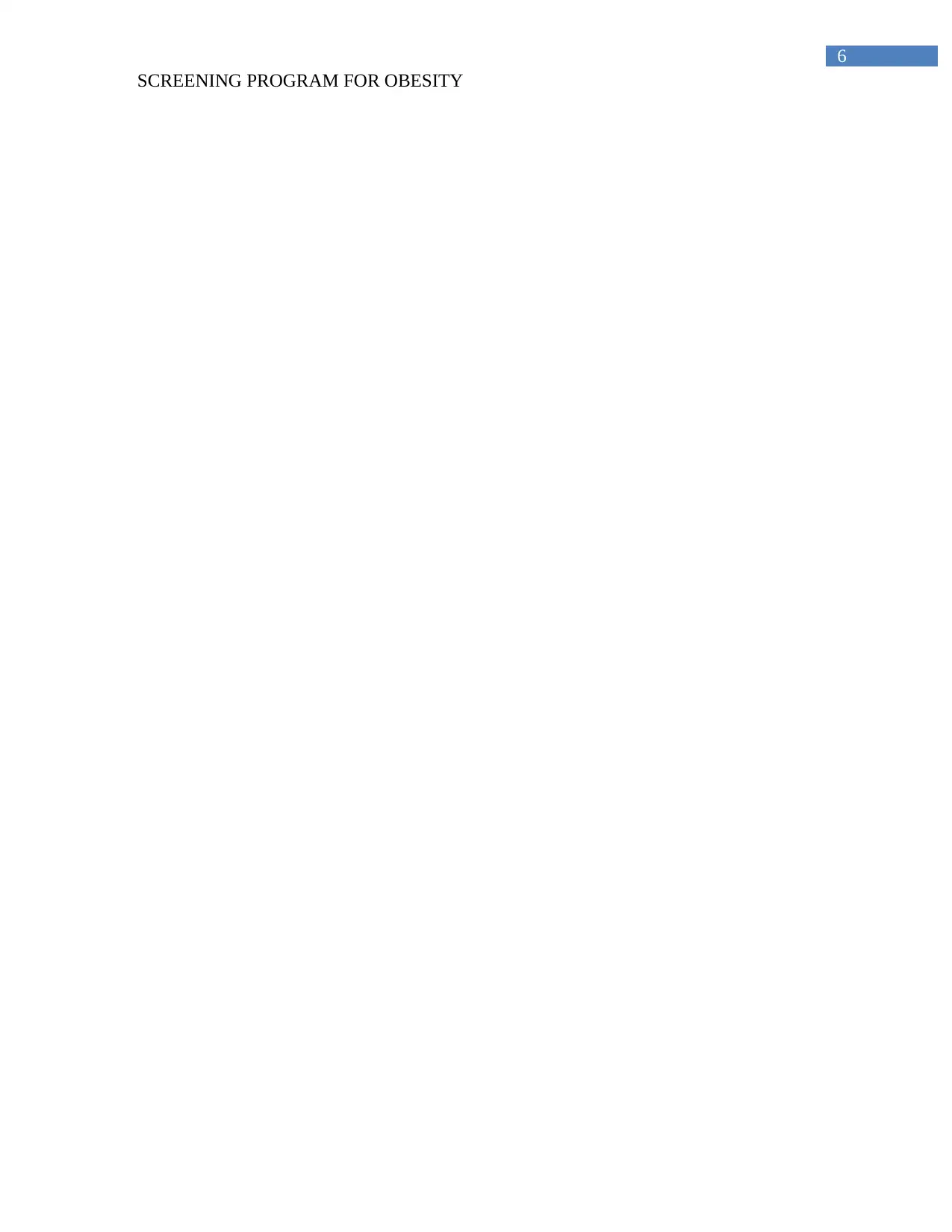
6
SCREENING PROGRAM FOR OBESITY
SCREENING PROGRAM FOR OBESITY
1 out of 7
Related Documents
Your All-in-One AI-Powered Toolkit for Academic Success.
+13062052269
info@desklib.com
Available 24*7 on WhatsApp / Email
![[object Object]](/_next/static/media/star-bottom.7253800d.svg)
Unlock your academic potential
Copyright © 2020–2025 A2Z Services. All Rights Reserved. Developed and managed by ZUCOL.





